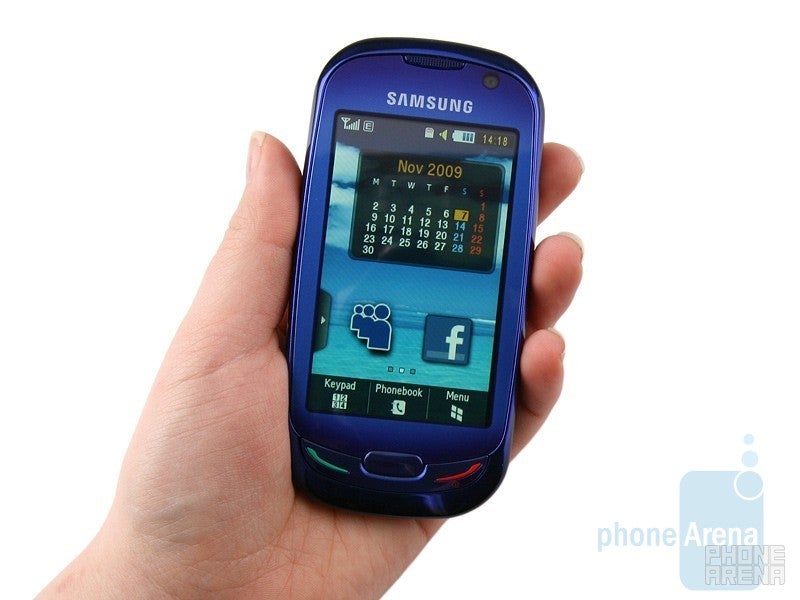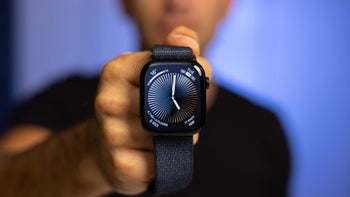Samsung Blue Earth S7550 Review

This is a global GSM phone. It can be used with AT&T and T-Mobile USA, but without 3G.
Introduction and design:
Brace yourselves! This is not just an ordinary review! You are in for an extensive essay on the power of Mother Nature, the poisonous influence of the human race, the ozone depletion and its impact on the shrinking population of white hamsters! Hey, where do you think you´re going? Come back! We promise we won´t go off the deep end and talk too much about the Earth´s ailing ecology… much. It´s just that the Samsung Blue Earth S7550 has made us think about issues that tend to escape our notice. We all go about our business and preoccupied with our busy daily routine we hardly ever consider things like “can we do more to save energy?”, “Are we doing enough about recycling?”, “What can we do to help nature?” and stuff like that. The Samsung Blue Earth S7550 is an environmentally-friendly handset in every single respect – its body and retail box are made from recycled materials entirely and there are solar panels on its back that help to extend the phone battery life in an ecologically consistent way.
It goes to show that using recycled materials (plastic water bottles in this case) doesn’t equate to worse overall appeal or build quality. The device feels a bit heftier (4.20 oz.) than normal for its size and the increase is mainly due to the extra weight of the integrated solar panels. It feels nice and pleasing in your hand, creating pretty much the same overall feeling that high-end devices like the Samsung Jet S8000 and Pixon12 do, while the mystical blue color of its face makes it stand out from the crowd.
Invalid image meta

You can compare the Samsung Blue Earth S7550 with many other phones using our Size Visualization Tool.
The Samsung Blue Earth S7550 sports a 3-inch capacitive screen with WQVGA resolution and overall sensitivity similar to the iPhone, which speaks volumes really. The image quality is quite good and the screen remains usable in direct sunlight.

The Blue Earth sports a very sensitive 3-inch capacitive touchscreen display
This looks somewhat counter-intuitive, but we suppose you would often find yourself holding the phone with its back rather than screen facing the Sun, especially on a clear day. The solar panels also give you something to brag about, telling you friends “Hey dude, look at that gizmo I got” and of course, help you to charge the phone battery. According to the manufacturer, an hour basking in the Sun equates to 10 minutes of talk on 3G networks or two extra hours in standby. We tested the solar panels on a cloudy day and we have to say they charge the battery relatively fast. If you point them towards a source of bright light (yes, you can charge the phone even in the light of a reading lamp), the small LED sensor on the back will glow in blue, while the battery indicator turns red showing you the device is being charged. Just keep in mind that charging is slower in overcast weather or when using domestic sources of light.
As a whole, all hardware buttons are easy to press and have well pronounced travel. The send and end keys are on the front side, along with the button that takes you a step back in the phone menus. The camera shutter and screen lock/unlock are on the right hand side of the handset, with the microUSB and charger ports directly above them, while the volume rocker is on the opposite side. This is somewhat irritating, but getting to the microSD and SIM card slots means you will have to remove the back panel.
As a whole, the Samsung Blue Earth S7550 is a likeable, eco-friendly handset with high build quality. Its compact size makes it quite comfortable to carry around in your pocket, while its offbeat face is memorable. The interesting thing is the eco-conscious workmanship and materials it´s made from do not squeeze the topic of its environmentally-friendly features dry, because the phone comes with relevant software functions as well. Keep reading to find out more.
Samsung Blue Earth S7550 360 Degrees View:
Interface and functions:
The Samsung Blue Earth S7550 runs the latest edition TouchWiz interface that comes with home screens, where you can place widgets and a main menu consisting of separate pages. Since we have already taken a comprehensive look at it in other reviews, say of the Samsung Jet S8000, we are not getting into details here, but we must tell you the Samsung Blue Earth S7550 is a snappy performer, despite the occasional lagging in certain applications and when scrolling the main menu. Unfortunately, the handset doesn’t have the multitasking capabilities of the Samsung Jet S8000.
The novelty features here are the eco functions. An application called Eco Walk is directly accessible from the home screen and shows you the number of trees you have helped to save, calories you have burnt and amount of carbon dioxide your trip would have produced if you had chosen to drive rather than walk. To get a proper reading, you should first customize your profile by entering the application menu and entering information about your step length, type of emissions your car produces (petrol, diesel, auto LPG), your body height and weight as well as how often the application counter should be automatically reset. Keep in mind the program uses the built-in accelerometer, so the reading is not absolutely accurate.
Being the vigilant, environmentally conscious people, we certainly decided to give the function a go. It turned out we had saved exactly… one tree and burned about 8 kilocalories. Feeling profound satisfaction with our accomplishment, we headed for the corner Burger King and pigged out on junk food. Long live the environment and the corner Burger King!
The Eco mode display setting is another eco-friendly feature of the phone. It helps you to save energy and extend battery life by decreasing the screen brightness and shortening the light time-out to 8 seconds.
The phone can also remind you to throw away the household waste or make sure you have not forgotten the water tap open. The function is quite entertaining at first, but will get you bored in a short while. Frankly, we turned it off after just a few minutes.
The Samsung Blue Earth S7550 has been designed with our environment in mind and this is great indeed. Unfortunately, the manufacturer has failed to meet the needs of people who love texting and surfing the Internet. The former will be disappointed at the lack of QWERTY keyboard – they will have to rely on standard alpha-numeric layout, which is not that bad really given the great screen sensitivity. The phone browser has been developed by Access and feels rather unhandy and clumsy to use alongside of the WebKit-based application the Samsung Jet S8000 and Pixon12 ship with. Scrolling feels overly sluggish and pages visualize with a lot of errors, rendering the Wi-Fi and 3G (HSDPA 3.6Mbps) connectivity options virtually useless.
The Samsung Blue Earth S7550 runs the latest edition TouchWiz interface that comes with home screens, where you can place widgets and a main menu consisting of separate pages. Since we have already taken a comprehensive look at it in other reviews, say of the Samsung Jet S8000, we are not getting into details here, but we must tell you the Samsung Blue Earth S7550 is a snappy performer, despite the occasional lagging in certain applications and when scrolling the main menu. Unfortunately, the handset doesn’t have the multitasking capabilities of the Samsung Jet S8000.
The novelty features here are the eco functions. An application called Eco Walk is directly accessible from the home screen and shows you the number of trees you have helped to save, calories you have burnt and amount of carbon dioxide your trip would have produced if you had chosen to drive rather than walk. To get a proper reading, you should first customize your profile by entering the application menu and entering information about your step length, type of emissions your car produces (petrol, diesel, auto LPG), your body height and weight as well as how often the application counter should be automatically reset. Keep in mind the program uses the built-in accelerometer, so the reading is not absolutely accurate.
Being the vigilant, environmentally conscious people, we certainly decided to give the function a go. It turned out we had saved exactly… one tree and burned about 8 kilocalories. Feeling profound satisfaction with our accomplishment, we headed for the corner Burger King and pigged out on junk food. Long live the environment and the corner Burger King!
The Eco mode display setting is another eco-friendly feature of the phone. It helps you to save energy and extend battery life by decreasing the screen brightness and shortening the light time-out to 8 seconds.
The phone can also remind you to throw away the household waste or make sure you have not forgotten the water tap open. The function is quite entertaining at first, but will get you bored in a short while. Frankly, we turned it off after just a few minutes.
The Samsung Blue Earth S7550 has been designed with our environment in mind and this is great indeed. Unfortunately, the manufacturer has failed to meet the needs of people who love texting and surfing the Internet. The former will be disappointed at the lack of QWERTY keyboard – they will have to rely on standard alpha-numeric layout, which is not that bad really given the great screen sensitivity. The phone browser has been developed by Access and feels rather unhandy and clumsy to use alongside of the WebKit-based application the Samsung Jet S8000 and Pixon12 ship with. Scrolling feels overly sluggish and pages visualize with a lot of errors, rendering the Wi-Fi and 3G (HSDPA 3.6Mbps) connectivity options virtually useless.
Camera and multimedia:
The Samsung Blue Earth S7550 will allow you to capture interesting things on your eco-friendly walks. You should predominantly count on getting decent pictures when taking them in the open and in proper lighting conditions. In this case the handset performs relatively well for an unpretending device with 3-megapixel camera that lacks autofocus. Its interface is very simplified and covers the basics, offering options like white balance, effects and shooting modes. The overall picture quality is decent, images lack enough details, but their colors appear realistically represented. As a whole, they are good enough to share over social networks and being browsed in small size. The phone captures videos at QVGA resolution and quite mediocre quality, so they are virtually useless.
The Samsung Blue Earth S7550 will fail to win over multimedia lovers. The music player itself is easy to use, but the audio quality is low with tracks sounding dull and not nearly loud enough through either the loudspeaker or the boxed headset. The lack of 3.5mm jack means there is no easy way of plugging in a better pair or any other dedicated audio accessory, say portable speakers or better headphones.
The handset plays MP4 videos with QVGA resolution and coded using MPEG-4 codec decently, but their quality is nothing to write home about. Unfortunately, it doesn’t support DivX and Xvid files either.
The Samsung Blue Earth S7550 will allow you to capture interesting things on your eco-friendly walks. You should predominantly count on getting decent pictures when taking them in the open and in proper lighting conditions. In this case the handset performs relatively well for an unpretending device with 3-megapixel camera that lacks autofocus. Its interface is very simplified and covers the basics, offering options like white balance, effects and shooting modes. The overall picture quality is decent, images lack enough details, but their colors appear realistically represented. As a whole, they are good enough to share over social networks and being browsed in small size. The phone captures videos at QVGA resolution and quite mediocre quality, so they are virtually useless.
The Samsung Blue Earth S7550 will fail to win over multimedia lovers. The music player itself is easy to use, but the audio quality is low with tracks sounding dull and not nearly loud enough through either the loudspeaker or the boxed headset. The lack of 3.5mm jack means there is no easy way of plugging in a better pair or any other dedicated audio accessory, say portable speakers or better headphones.
The handset plays MP4 videos with QVGA resolution and coded using MPEG-4 codec decently, but their quality is nothing to write home about. Unfortunately, it doesn’t support DivX and Xvid files either.

Whatever the eco-friendly features of a handset, you will still need to pollute the environment with radio emissions whenever you feel like making a call. Talking on the Samsung Blue Earth S7550 makes for a relatively pleasing experience, at least in terms of in-call quality. Sound is loud indeed, even if a bit sharp at times and ultimately we didn’t have any problems catching onto our callers, who also said things were fine on their end.
Keeping in mind you are actually able to charge the phone battery the whole day, you would hardly ever face any troubles relating to its average life on a single charge. We managed to get almost three full days out of the battery before we had to recharge it, although we didn’t use the device extensively during our tests and kept it in properly lit places almost all the time.
Conclusion:
The Samsung Blue Earth S7550 is interesting in that it´s the first eco-friendly handset equipped with touch-sensitive screen and coming with contemporary design. Its functionality not only covers all the basics, but even goes even further. The phone is aimed at a (still) small market niche – people who do care about nature. If you happen to be one of them and need a handset with touch-sensitive display, you are out of options at this time – you should either go for the Samsung Blue Earth S7550 or wait until the LG Pop GD510 has hit the shelves. You should know, however, that the latter will come with body made of eco-unfriendly aluminum, while its solar panel will be an additional accessory.
Ordinary people who want the best bang for the buck and are not profoundly interested in saving trees, well, have better options than the Samsung Blue Earth S7550. There are many devices with much better functionality on the market now, like the Samsung BEAT DJ M7600 and Nokia 5800 XpressMusic that actually belong to the same price category.
The Samsung Blue Earth S7550 goes to show that modern handsets need not be environmentally unfriendly. We hope we get to see more similar products in the future, because it´s about time we started thinking about the environment that we share. Getting the ball rolling is always hard when it comes to novelty ideas and we know that, but we hope we will all manage to bring up a more environmentally conscious generation and the Blue Earth is a step in the right direction.
Samsung Blue Earth S7550 Video Review:














Things that are NOT allowed:
To help keep our community safe and free from spam, we apply temporary limits to newly created accounts: